Abstract
Due to its high greenhouse effect, the use of SF6 as the main insulating gas is restricted in the electric power field. Along with the aim of environmental protection, the search for new alternative gases with a lower greenhouse effect and higher insulation strength has received a lot of attention. The properties of alternative gases have a vital impact on the performance of medium-voltage power distribution equipment. Firstly, based on the existing liquefaction temperatures of SF6/N2, SF6/CO2, and SF6/CF4, the calculated liquefaction temperatures were expanded to 0.7 MPa. Combining the Antoine vapor-pressure equation and the basic law of vapor–liquid balance, the vapor pressures of SF6/N2, CF3I/N2, c-C4F8/N2, C4-PFN/N2, C4-PFN/CO2, and C5-PFK/CO2 were obtained. Secondly, the critical breakdown field strength was analyzed for C4-PFN/CO2, C5-PFK/CO2, SF6, CF3I/N2, C5-PFK/Air, and c-C4F8/N2. Finally, the GWPs of SF6/N2, C4-PFN/N2, C4-PFN/CO2, C5-PFK/CO2, and C5-PFK/N2 were discussed. The results show that the liquefaction temperature gradually decreases as the pressure rises; SF6/N2 has the highest vapor pressure at −5 °C; the critical breakdown field strengths of several mixtures are higher than that of SF6.
1. Introduction
Since the beginning of the 21st century, the greenhouse effect has become one of the biggest challenges for mankind. Due to the unregulated emission of greenhouse gases, the disadvantages of global warming have become more and more prominent. The excellent performance of the SF6 gas in insulation and its arc-extinguishing performance makes it absolutely dominant in the power system, [1] but its GWP value is about 23,900 times greater than that of CO2 and its atmospheric life is about 3400 years. It is a big threat to the environment. In 1997, more than 100 countries signed the Kyoto Protocol to control greenhouse gas emissions, thus limiting the use of SF6 [2]. In addition, SF6 has some inherent defects such as its high cost, sensitivity to inhomogeneous electric fields, being unsuitable for alpine areas, and its toxic decomposition products [3]. In the field of electric power, it is an inevitable trend to restrict and replace the use of SF6 [4]. It is the demand of the electric power field to find new alternative gases with more stable chemical properties, lower GWP value, and higher insulation strength.
At present, the alternative gases are mainly divided into three categories [5]. The first is the simple insulating gas such as air, N2, CO2, etc. These gases have stable chemical properties, low cost, require simple preparation, lower liquefaction temperature, and have a lower greenhouse effect. Toshiaki et al. [6] investigated the insulation strength of N2, CO2, and dry air. They found that the insulation strength of dry air was greater than that of N2 and CO2 at 0.5 MPa. The insulation strength of dry air at 0.6 MPa is less than that of the SF6/N2 gas mixture. Aanensen et al. [7] found that the arc extinguishing ability of CO2 is stronger than that of dry air, and it is possible to replace SF6 in all aspects. Guo et al. [8] analyzed the breakdown characteristics of the CO2/O2 mixture. Yousfi et al. [9] and Basurto et al. [10] measured the critical breakdown characteristics of CO2 and its mixture with SF6, N2, and O2 using the Thomson pulse discharge method. Lim et al. [11] studied the insulation characteristics of N2 and compressed air, and made a prospect for the alternative gas of medium-voltage equipment. However, the simple insulating gases have some disadvantages. Pure N2 has low insulation strength due to its poor electron adsorption ability. In order to reach the insulation strength of SF6, the pressure of N2 needs to be increased to 3–4 times that of SF6. The increase in pressure means an increase in the size of the equipment, the floor area of the equipment, and the economic cost. Therefore, it is necessary to determine the application of these gases according to the actual situation.
The second is the mixture of SF6 with air, N2, CO2, or other gases. SF6 quickly occupies the power system because of its excellent insulation ability, but the liquefaction temperature of pure SF6 is high. This greatly limits its use in cold areas. Even worse, its GWP value is very high so that it does not contribute to the concept of environmental protection. To solve these problems, researchers have put forward the idea of “partial substitution” and tried to mix N2, CO2, or dry air with SF6. This not only effectively reduces the liquefaction temperature, but also reduces GWP. Pinheiro et al. [12] simulated the critical breakdown field strength of mixtures of SF6 with He, Xe, CO2, and N2. They found that the SF6/N2 mixture has the highest critical breakdown field strength. Lee et al. [13] studied the breakdown characteristics of 40 kinds of gas mixtures. Their results show that the breakdown characteristics of the SF6/N2 mixture are closest to those of pure SF6. Hernández-Ávila et al. [10] measured the electron transport parameters and breakdown characteristics of SF6/CO2 at different mixing ratios. Wang et al. [14] analyzed the critical breakdown strength of SF6/CO2 and SF6/He mixtures. Zhao et al. [15] calculated the critical breakdown field strength of SF6/N2 at −15 °C and −25 °C.
The third is the new electronegative gas [16,17]. The “partial substitution” method can only temporarily solve the insulation problem of medium-voltage distribution in alpine regions. In the long run, the trend of medium-voltage distribution in the insulation medium field will have to find substitutes with more stable chemical properties, higher insulation strength, and lower GWP. At present, perfluorocarbons (c-C4F8, CF3I, C5F10O, C6F12O, C4F7N, C3F8, C2F6) as electronegative gases are often studied. Because of the special chemical structure, their insulating properties are strong. What is more important is that their GWPs are far lower than that of pure SF6, which means they are not destructive to the ozone layer. However, the electronegative gases have high liquefaction temperatures, which seriously limit their application. For example, the liquefaction temperatures of C5F10O and C6F12O gases are at 26.5 °C and 49 °C at atmospheric pressure, respectively [18], which obviously cannot meet the application in alpine regions. To reduce the liquefaction temperatures of insulating media, a certain proportion of buffer gas (CO2, N2 or CF4) can be added to these gases.
From this analysis, the existing research shows that the abovementioned gases cannot fully meet the requirements of SF6 replacement. The performance of an electronegative gas mainly depends on its properties (critical breakdown field strength, liquefaction temperature, saturated vapor pressure). However, few systematic studies have addressed the properties of electronegative gas. Thus, in order to provide a scientific basis for the development of power equipment that would contribute to environmental protection, we analyze the advantages and limitations of the three kinds of SF6 alternative gases mentioned above and study the influence of different components of the mixed gases on liquefaction temperature, saturated vapor pressure, and critical breakdown field strength, on the basis of these properties and their GWP.
2. Saturated Vapor Pressure and Liquefaction Temperature
2.1. Calculated Model
Pure SF6 as an insulating medium has higher saturated vapor pressure, and it needs to add N2, CO2, CF4, or other buffer gases to reduce the saturated vapor pressure and liquefaction temperature. Therefore, it is necessary to explore the liquefaction temperatures and saturated vapor pressures of the mixtures. According to the existing liquefaction temperature data of SF6/N2, SF6/CO2 and SF6/CF4 at 0.3 MPa, 0.5 MPa, and 0.7 MPa [6], the equation for obtaining the liquefaction temperature is as follows:
where p is the pressure (MPa), x is the insulating medium fraction, and t is the liquefaction temperature (°C). The fitting parameters (A, B, C, D) are shown in Table 1.

Table 1.
Parameters of each gas mixture.
Using the equation above, the liquefaction temperatures of mixed gases were calculated for three groups ranging from 0.1 to 0.7 MPa. Figure 1 shows the experimental and calculated results for three groups under 0.5 MPa. From the calculated results, it can be seen that the accuracy of our model is good, which can thus meet the engineering application. We can further explore the liquefaction temperature of mixed gases under different pressures using this model.
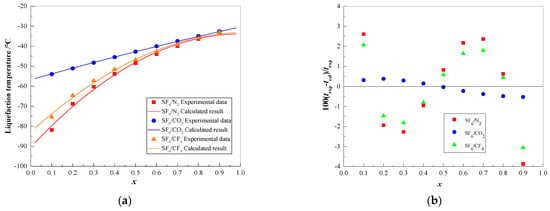
Figure 1.
Comparison of experimental and calculated liquefaction temperatures for three groups at 0.5 MPa.
Since the saturated vapor pressure of mixed gas is difficult to measure by experiments, we used the combination of the Antoine vapor pressure equation and the basic law of gas–liquid balance to determine the fit and regression values of the saturated vapor pressure of the existing mixed gas [19]. The specific equation is as follows:
where and are the saturated vapor pressures of pure components 1 and 2, respectively; t1, t2 are the liquefaction temperatures of components 1 and 2, respectively; A, B, C are the Antoine Constants; p is the saturated vapor pressure of the mixed gas; x and y are the mole fractions of the liquid and gas phases, respectively.
2.2. Calculated Results
The liquefaction temperatures, as shown in Figure 2, were calculated for different components of SF6/N2, SF6/CO2, and SF6/CF4 at a pressure of 0.1~0.7 MPa using the equations above.
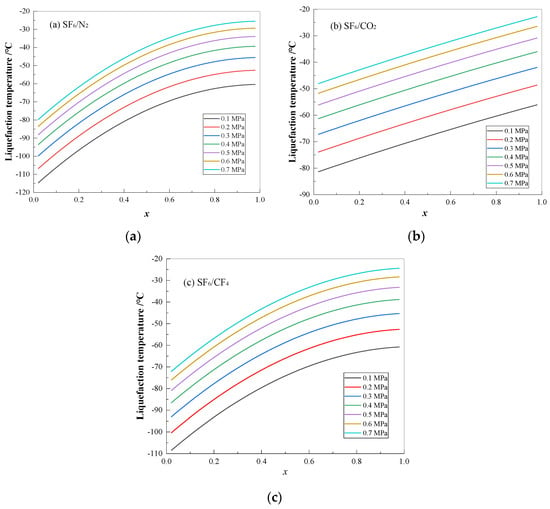
Figure 2.
The relationship between the liquefaction temperature of the three mixed gases and the concentration of the components.
From Figure 2, we can see that the liquefaction temperature was affected by the mixing ratio and pressure. As the mixing ratio of SF6 increases, the liquefaction temperature of the mixture continues to rise in a non-linear trend. Compared to SF6/N2 and SF6/CF4, SF6/CO2 has a weak nonlinearity. When the mixing ratio is the same, the liquefaction temperature appears to increase as the pressure increases. As shown in Figure 2c, for example, when x takes the value of 0.4, the liquefaction temperature at 0.1 MPa is about −79.54 °C; the liquefaction temperature at 0.7 MPa is about −43.18 °C.
Figure 3 shows the liquefaction temperature of SF6/N2, SF6/CO2, and SF6/CF4 at pressures of 0.2, 0.4, and 0.6 MPa. It can be seen that the liquefaction temperature of the mixed gas has a similar upward trend as the mixing ratio x changes, but the liquefaction temperature is different due to the different types of mixed gases. Taking Figure 3c as an example, when the pressure is 0.6 MPa, the liquefaction temperature has the following relationship: SF6/N2 < SF6/CF4 < SF6/CO2. As the mixing ratio of the insulating medium increases, the three liquefaction temperatures gradually approach the same level. When x = 0.2, the liquefaction temperature of SF6/N2 is about −46.54 °C, while that of SF6/CF4 is about −60.78 °C, and that of SF6/CO2 is about −65.54 °C. When x = 0.4, the three liquefaction temperatures are −41.01 °C, −47.17 °C, and −49.72 °C, respectively. This shows that the addition of N2, CO2, CF4 or other buffer gases does effectively reduce the liquefaction temperature of SF6. The higher the buffer gas content, the lower the liquefaction temperature of the mixed gas. There are similar conclusions under other pressures.
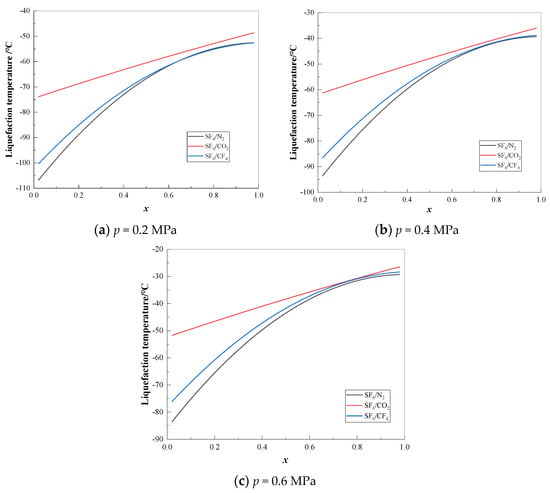
Figure 3.
The relationship between the liquefaction temperature of the mixed gas and the mixing ratio x under different pressures.
According to the Antoine vapor pressure equation and the basic law of gas–liquid equilibrium, we selected electronegative gases with higher insulating media (C4-PFN, C5-PFK, c-C4F8, and CF3I) and buffer gases (N2 and CO2) as the research objects in order to explore the saturated vapor pressure of mixed gases under different conditions. Figure 4 shows the calculated saturated vapor pressures of mixed gases at a mixing ratio of 1:9 and at temperatures from −50 to 50 °C. Figure 5 compares the saturated vapor pressures of studied mixed gases at −5 °C.
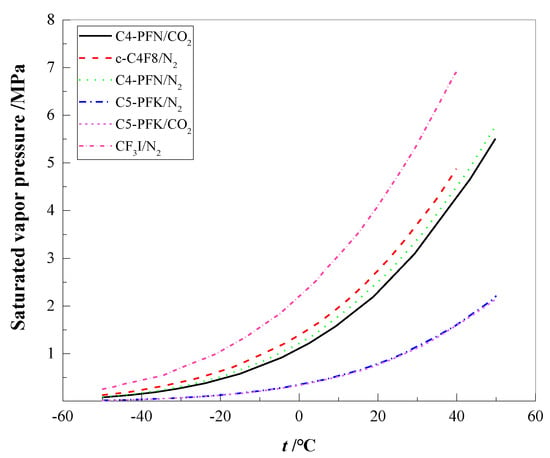
Figure 4.
Comparison of saturated vapor pressure within −50~50 °C at a mixing ratio of 10%/90%.

Figure 5.
Comparison of the saturated vapor pressure of mixed gases at a temperature of −5 °C.
As can be seen in Figure 4: (1) Under the mixing ratio (10%/90%), the six groups show the same trend when the temperature changes, that is, as the temperature rises, the saturated vapor pressure of each group of mixed gases increases. For example, when the temperature is −40 °C, the saturated vapor pressure of CF3I/N2 is about 0.423 MPa, and when the temperature is −20 °C, its saturated vapor pressure is about 1.058 MPa. (2) At the specified temperature, the saturated vapor pressure is as follows: CF3I/N2 > c-C4F8/N2 > C4-PFN/N2 > C4-PFN/CO2 > C5-PFK/N2 > C5-PFK/CO2. Under the mixing ratio, the saturated vapor pressure curve of CF3I/N2 between −50 and 50 °C is significantly higher than that of other mixed gases. When considering the characteristic of saturated vapor pressure alone, CF3I/N2 has the best saturated vapor pressure performance at a mixing ratio of 10%/90%.
Based on Figure 5, it can therefore be concluded that the saturated vapor pressures of all mixed gases exhibit a similar trend as the mixing ratio of the insulating gas increases at −5 °C. The saturated vapor pressure of each mixed gas increases with the rising mixing ratio of the insulating medium. Taking SF6/N2 as an example, the saturated vapor pressure is at about 5.47 MPa when x = 0.2. When x = 0.4, the saturated vapor pressure is at about 2.93 MPa. The saturated vapor pressure values of the mixed gases are as follows: SF6/N2 > CF3I/N2 > c-C4F8/N2 > C4-PFN/N2 > C4-PFN/CO2 > C5-PFK/CO2, with SF6/N2 having the highest saturated vapor pressure at −5 °C. When considering only the characteristics of saturated vapor pressure, CF3I/N2 appears to be the mixed gas most likely to replace SF6/N2, but there is still a certain gap between the two values.
3. Critical Breakdown Field Strength and GWP Value
Safar et al. [20] studied the breakdown characteristics of SF6 mixed with N2, CO2, and air. They found that the breakdown characteristics of the SF6/CO2 mixture at a specific pressure and mixing ratio are even stronger than that of pure SF6. Hwang et al. [21] and Zhao et al. [22] investigated the breakdown characteristics of SF6/CF4. Li et al. [18] measured the critical breakdown field strength of C4F7N and C5F10O mixed with CO2. The experiment showed that the addition of CO2 effectively increased the critical breakdown field strength, and that the characteristics of the mixed gas even surpassed those of SF6 at a certain ratio, pressure, and temperature. Yamamoto et al. [23] compared the breakdown strength of c-C4F8/N2, c-C4F8/CO2, and c-C4F8/air. Zhao et al. [15] analyzed the critical breakdown field strength of C4-PFN/CO2 and SF6/CO2 at −15 °C and −25 °C. Based on the abovementioned research, we summarized the critical breakdown field strength of a variety of mixed substitute gases at −25 °C, as shown in Figure 6.
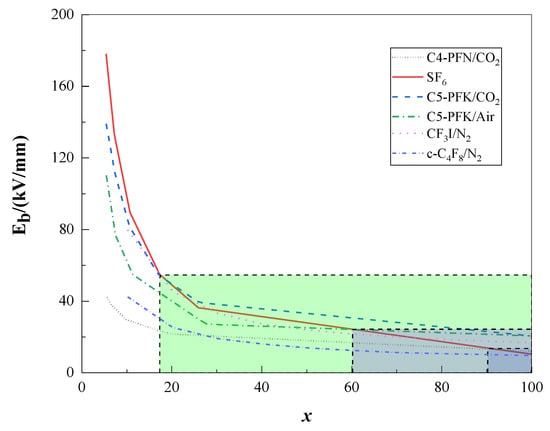
Figure 6.
Comparison of the critical breakdown field strength of mixed gases at −25 °C.
Figure 6 shows that pure SF6 has the highest critical breakdown field strength when x < 17.3%. When x > 17.3%, the critical breakdown field of C5-PFK/CO2 is stronger than that of pure SF6. When x > 60.2%, the critical breakdown field of C5-PFK/Air is stronger than that of pure SF6. When x > 90.2%, the critical breakdown field of C4-PFN/CO2 is stronger than that of pure SF6, but the critical breakdown field strength of c-C4F8/N2 is smaller than that of SF6. The critical breakdown field of CF3I/N2 is stronger than that of pure SF6 when x > 74.5%. Therefore, a mixed gas in the appropriate mixing ratio can be selected in the actual demand to replace pure SF6.
SF6 has a high GWP, which is a major defect. Therefore, it is necessary to study the GWP of alternative mixed gases. Figure 7 shows a comparison of the GWP changes of each mixed gas under different mixing ratios. From Figure 7, we can see that SF6/N2 has the highest GWP, followed by C4-PFN/N2, C4-PFN/CO2, C5-PFK/CO2, and C5-PFK/N2. Therefore, when only GWP is used as a basis for reference, C5-PFK/N2 is the mixed gas with the greatest advantage.
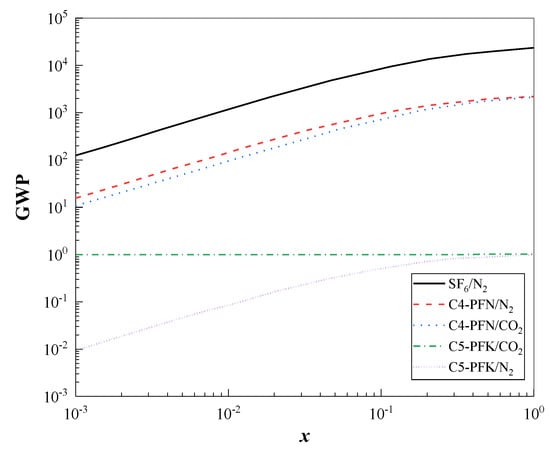
Figure 7.
The relationship between working fluid to mixing ratio and GWP.
4. Conclusions
In order to find the suitable alternative gas in the field of medium-voltage power distribution equipment, the advantages and limitations of three kinds of SF6 substitutes were analyzed based on the thermodynamic properties. Using the discrete data, the liquefaction temperatures of SF6/N2, SF6/CO2, and SF6/CF4 were obtained from 0.1 to 0.7 MPa. Under the same pressure, the liquefaction temperatures of mixed gases showed an upward trend as the proportion of SF6 increased. Since the saturated vapor pressure of mixed gas is difficult to obtain by experiments, the Antoine vapor pressure equation and basic law of gas–liquid balance were combined to calculate the saturated vapor pressure of the mixed gases. When the ratio of mixed gas was determined, the saturated vapor pressure of the mixed gas demonstrated an increase with the increase in temperature. The order of the saturated vapor pressure values is as follows: CF3I/N2 > c-C4F8/N2 > C4-PFN/N2 > C4-PFN/CO2 > C5-PFK/N2 > C5-PFK/CO2. Compared to the critical breakdown field strengths of mixed gases, we found that the critical breakdown field strength of each mixed gas has different degrees of decline when buffer gas is added. C5-PFK/CO2 when x > 17.3%, C5-PFK/Air when x > 60.2%, CF3I/N2 when x > 74.5%, and C4-PFN/CO2 when x > 90.2%; the critical breakdown field strengths of these mixed gases exceeded that of pure SF6. The critical breakdown field strength of c-C4F8/N2 is always less than that of SF6. According to the GWP analysis of SF6/N2, C4-PFN/N2, C4-PFN/CO2, C5-PFK/CO2, and C5-PFK/N2, it was C5-PFK/N2 that had the lowest GWP. C5-PFK/CO2 also has better GWP. Research on the substitution of SF6 gas is a long process. It is not advisable to replace SF6 by considering only a single superior property. The characteristics of liquefaction temperature, saturated vapor pressure, critical breakdown field strength, and GWP should be considered comprehensively.
Author Contributions
Writing—original draft, T.J.; Validation, X.M.; Writing—review & editing, X.M. and L.J.; Investigation, Q.W.; Methodology, Y.S. All authors have read and agreed to the published version of the manuscript.
Funding
The authors are grateful for financial support from the National Natural Science Foundation of China (No.51606148); Natural Science Basic Research Project of Shaanxi Province (2020JM-036).
Data Availability Statement
The data presented in this study are available on request from the corresponding author.
Conflicts of Interest
The authors declare no conflict of interest.
References
- Zhang, X.; Tian, S.; Xiao, S.; Li, W. Summary of research status of SF6 substitute gas. J. Electrotech. Technol. 2018, 12, 2883–2893. [Google Scholar]
- Yan, X.; Gao, K.; Zheng, Y.; Li, Z.; Wang, H.; He, J.; Liu, Y. Research progress of SF6 mixed gas and substitute gas. Power Grid Technol. 2018, 6, 1837–1844. [Google Scholar]
- Zhou, Z.; Han, D.; Zhao, M.; Zhang, G. Research review on the decomposition characteristics of SF6 substitute gas. Trans. Chin. Soc. Electr. Eng. 2020, 35, 4998–5014. [Google Scholar]
- Chen, Q.; Qiu, R.; Lin, L.; Cheng, S.; Zhang, C. Screening of SF6 Potential Alternative Gases Based on Density Functional Theory. High Volt. Technol. 2019, 45, 1026–1033. [Google Scholar]
- Li, X.; Zhao, H. Summary of research progress of SF6 substitute gas. High Volt. Technol. 2016, 6, 1695–1701. [Google Scholar]
- Rokunohe, T.; Yagihashi, Y.; Endo, F.; Oomori, T. Fundamental Insulation Characteristics of Air, N2, CO2, N2/O2 and SF6/N2 Mixed Gases. IEEE Trans. Power Energy 2005, 125, 619–625. [Google Scholar] [CrossRef][Green Version]
- Aanensen, N.S.; Jonsson, E.; Runde, M. Air-Flow Investigation for a Medium-Voltage Load Break Switch. IEEE Trans. Power Deliv. 2015, 30, 299–306. [Google Scholar] [CrossRef]
- Guo, X.; Zhao, H.; Li, X. Calculation and analysis of thermal properties and electric shock penetration characteristics of hot CO2 and its mixture with O2. High Volt. Technol. 2014, 40, 3085–3090. [Google Scholar]
- Yousfi, M.; Urquijo, J.D.; Juarez, A.; Basurto, E.; Hernandez-Avila, J.L. Electron swarm coefficients in CO2-N2 and CO2-O2 mixtures. IEEE Trans. Plasma Sci. 2009, 37, 764–772. [Google Scholar] [CrossRef]
- Hernández, J.L.; Basurto, E.; De Urquijo, J. Electron transport and swarm parameters in CO2 and its mixtures with SF6. J. Phys. D Appl. Phys. 2002, 35, 2264. [Google Scholar] [CrossRef]
- Lim, D.Y.; Bae, S. Study on oxygen/nitrogen gas mixtures for the surface insulation performance in gas insulated switchgear. IEEE Trans. Dielectr. Electr. Insul. 2015, 22, 1567–1576. [Google Scholar] [CrossRef]
- Pinheiro, M.J.; Loureiro, J. Effective ionization coefficients and electron drift velocities in gas mixtures of SF6 with He, Xe, CO2 and N2 from Boltzmann analysis. J. Phys. D Appl. Phys. 2002, 35, 3077. [Google Scholar] [CrossRef]
- Lee, A.; Frost, L.S. Interruption Capability of Gases and Gas Mixtures in a Puffer-Type Interrupter. Plasma Sci. IEEE Trans. 1980, 8, 362–367. [Google Scholar] [CrossRef]
- Wang, W.; Tu, X.; Mei, D.; Rong, M. Dielectric breakdown properties of hot SF6/He mixtures predicted from basic data. Phys. Plasmas 2013, 20, 1018–1029. [Google Scholar] [CrossRef]
- Zhao, H.; Li, X.; Tang, N.; Jiang, X.; Guo, Z.; Lin, H. Dielectric properties of fluoronitriles/CO2 and SF6/N2 mixtures as a possible SF6-substitute gas. IEEE Trans. Dielectr. Electr. Insul. 2018, 25, 1332–1339. [Google Scholar] [CrossRef]
- Wang, C.; Li, J.; Cao, Y.; Yu, L.; Cui, J. Research on the performance of C4F7N/CO2 mixed gas arc extinguishing. Electr. Appl. Energy Effic. Manag. Technol. 2021, 4, 1–6. [Google Scholar]
- Zhuo, R.; Ke, K.; Zhang, Y.; Fu, M.; Wang, D.; Xiang, J.; Zhang, X. Insulation characteristics of C5F10O/dry air and C5F10O/N2 under quasi-uniform electric field. Electr. Power Eng. Technol. 2021, 40, 159–165. [Google Scholar]
- Li, X.; Deng, Y.; Jiang, X.; Zhao, H.; Zhuo, R. Insulation performance and application of mixed gases of environmental protection gases C4F7N and C5F10O and CO2. High Volt. Technol. 2017, 43, 708–714. [Google Scholar]
- Simka, P.; Ranjan, N. Dielectric strength of C5 Perfluoroketone. In Proceedings of the 19th International Symposium on High Voltage Engineering, Pilsen, Czech Republic, 23–28 August 2015. [Google Scholar]
- Safar, Y.A.; Malik, N.H.; Qireshi, A.H. Impulse Breakdown Behavior of Negative Rod-Plane Gaps in SF6-N2, SF6-Air and SF6-CO2 Mixtures. IEEE Trans. Electr. Insul. 1982, 5, 441–450. [Google Scholar] [CrossRef]
- Hwang, C.H.; Lee, B.T.; Huh, C.S.; Kim, N.R.; Chang, Y.M. Breakdown characteristics of SF6/CF4 mixtures in 25.8 Kv. In Proceedings of the International Conference on Electrical Machines & Systems, Tokyo, Japan, 15–18 November 2009. [Google Scholar]
- Zhao, H.; Li, X.; Jia, S.; Liu, Z.; Dong, Q. Study on electrical breakdown characteristics of 50% SF6-50% CF4 mixed gas at 1 atmosphere. Chin. Soc. Electr. Eng. 2013, 19, 200–207. [Google Scholar]
- Yamamoto, O.; Takuma, T.; Hamada, S.; Yamakawa, Y.; Yashima, M. Applying a Gas Mixture Containing c-C[sub4]F[sub8] as an Insulation Medium. IEEE Trans. Dielectr. Electr. Insul. 2001, 6, 1075. [Google Scholar] [CrossRef]
Publisher’s Note: MDPI stays neutral with regard to jurisdictional claims in published maps and institutional affiliations. |
© 2021 by the authors. Licensee MDPI, Basel, Switzerland. This article is an open access article distributed under the terms and conditions of the Creative Commons Attribution (CC BY) license (https://creativecommons.org/licenses/by/4.0/).